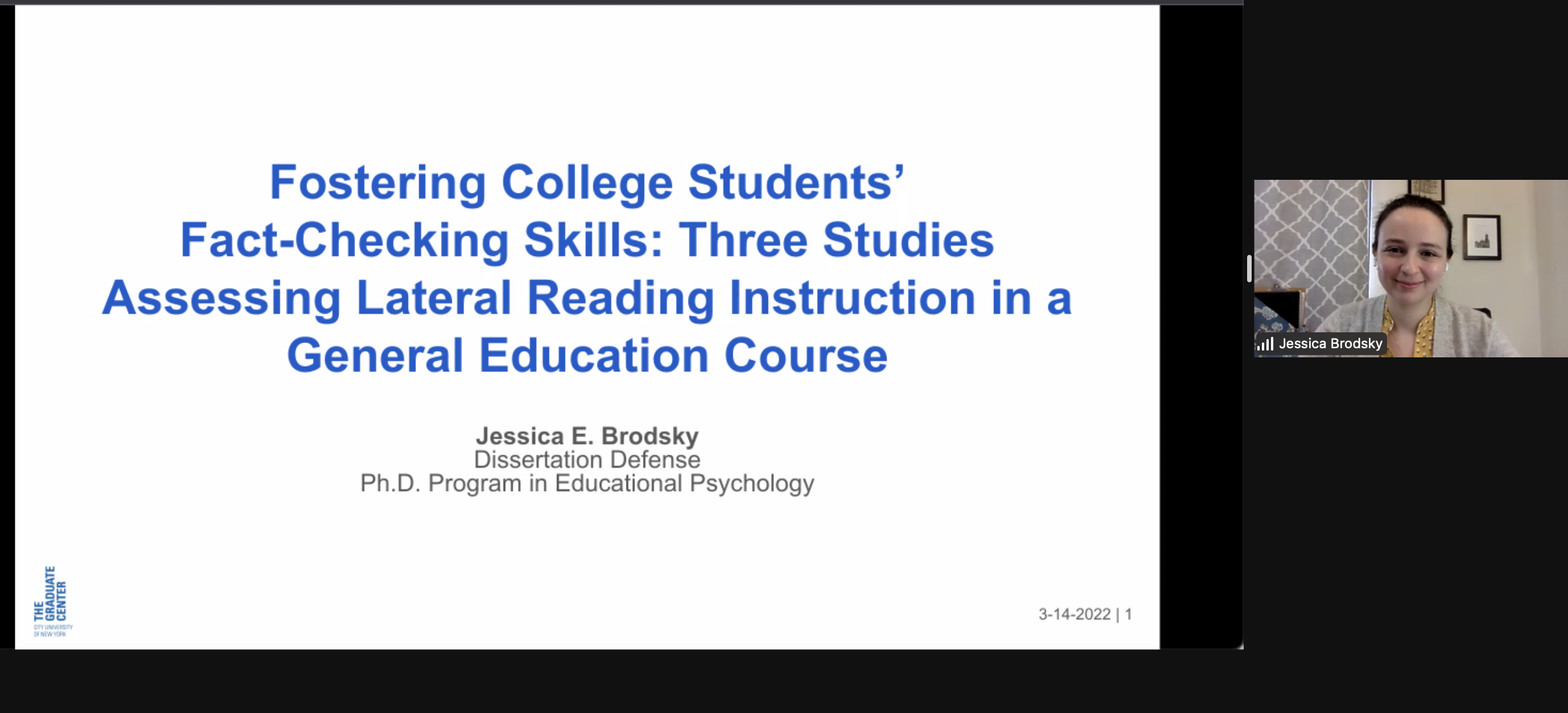
Jessica Brodsky presenting her dissertation
Congrats to Jessica Brodsky who successfully defended her dissertation on “Fostering College Students’ Fact-Checking Skills: Three Studies Assessing Lateral Reading Instruction in a General Education Course”
Committee Members:
Chair: Dr. Patricia J. Brooks, The College of Staten Island / The Graduate Center, CUNY
Dr. Bruce Homer, Educational Psychology, The Graduate Center, CUNY
Dr. Jay Verkuilen, Educational Psychology, The Graduate Center, CUNY
Readers:
Dr. Fran C. Blumberg, Division of Psychological and Educational Services, Fordham University
Dr. Sarah McGrew, Department of Teaching and Learning, Policy and Leadership, University of Maryland
Abstract:
While online information is abundant and easily accessible, its quality varies widely. Fact-checkers evaluate online information by reading laterally, i.e., leaving content to research sources and verify claims. This dissertation consisted of three studies that used course outcomes assessment data to examine the impact of a lateral reading curriculum on college students’ fact-checking skills. The curriculum was first implemented in Fall 2018 as part of a general education civics course. It has been taught every semester since then, though the content and format of implementation have changed. Data used in the current studies were collected during the Fall 2018, Fall 2019, and Fall 2020 semesters.
The Fall 2018 study used a pre/posttest control-group design to evaluate an in-person implementation of a curriculum teaching students four fact-checking “moves.” Students who received the curriculum were more likely to read laterally and accurately assess the trustworthiness of online content at posttest than controls. They also reported greater use of Wikipedia at posttest than controls, but did not show significantly greater trust. Students in the curriculum condition that read laterally on at least one problem at posttest completed more online assignments reviewing lateral reading strategies than their peers. Across conditions, students demonstrated high general media literacy knowledge, but this was unrelated to performance at posttest or responsiveness to the curriculum.
The Fall 2019 study used a pre/post control-group design to evaluate an asynchronous, online version of the curriculum which taught students a revised set of fact-checking moves summarized by the acronym “SIFT.” Students who received the curriculum were more likely to read laterally and were more aware of lateral reading strategies at posttest than controls. Students who used lateral reading strategies during the curriculum had higher reading comprehension and better posttest outcomes. Lateral reading use and awareness were unrelated at pretest. At posttest, use and awareness were weakly correlated, while reading comprehension was weakly correlated with use and moderately correlated with awareness. Awareness of lateral reading strategies fully mediated the effect of reading comprehension on use of lateral reading at posttest.
Lastly, given the proliferation of false and misleading information surrounding the COVID-19 pandemic, the Fall 2020 study assessed how gains in lateral reading from the asynchronous, online SIFT curriculum related to students’ confidence in their ability to fact-check COVID-19-related news. Students made gains in their use of lateral reading from pretest to posttest, with both reading comprehension and assignment completion significantly predicting use. Students also made gains in their confidence in fact-checking COVID-19-related news, as well their use, endorsement, and knowledge of Wikipedia. At posttest, use of lateral reading was only weakly correlated with fact-checking confidence.
The three studies in this dissertation add to the growing literature documenting both the dearth of lateral reading skills among college students and the efficacy of educational interventions for increasing students’ use of these skills. While findings are encouraging, students’ gains were also modest. These studies identify factors that may explain individual differences in students’ use of lateral reading after instruction, including awareness of lateral reading strategies, attitudes, use, and knowledge of Wikipedia, and reading comprehension.




No comments yet.